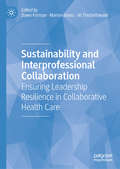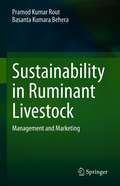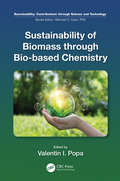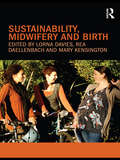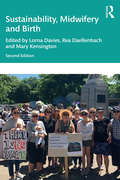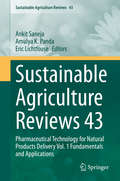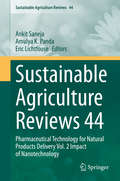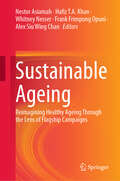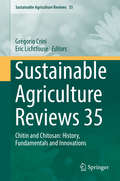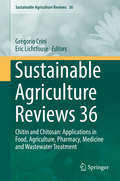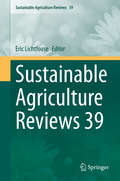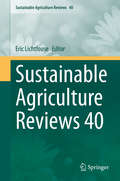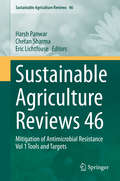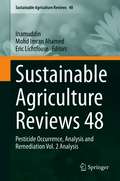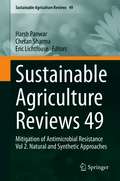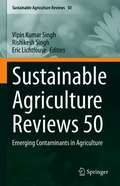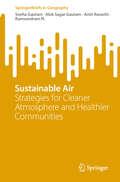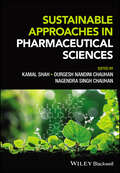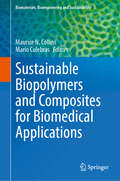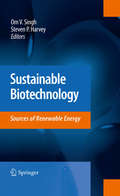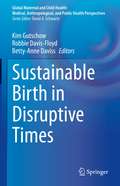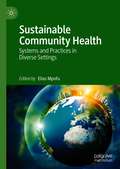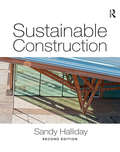- Table View
- List View
Sustainability and Interprofessional Collaboration: Ensuring Leadership Resilience in Collaborative Health Care
by Marion Jones Jill Thistlethwaite Dawn FormanThis book is the fourth in the series on leadership, interprofessional education and practice, following on from Leadership Development for Interprofessional Education and Collaborative Practice (2014), Leadership and Collaboration: Further Developments for IPE and Collaborative Practice (2015) and Leading Research and Evaluation in Interprofessional Education and Collaborative Practice (2016). Along with policy changes around the globe, these three books have stimulated experts in this area to consider not only the ways in which they introduce and develop interprofessional education and collaborative practice, but also how they evaluate their impacts. In this 4th book, the focus is on the sustainability of these initiatives, sharing insights into factors that promote sustainability including leadership approaches and organisationsal resilience, as well as frequently encountered difficulties, and ways to overcome them.
Sustainability in Ruminant Livestock: Management and Marketing
by Basanta Kumara Behera Pramod Kumar RoutThis book presents a concept for implementing a mass balance approach toward developing an effective eco-friendly, livestock farming system independent of external energy input. In this context it describes a modern, integrated farming system, and includes comprehensive technical information explaining the design and evaluation of manure management systems, and modeling and operational tools. It first discusses the mass balance operating process, highlighting the difference between imported and exported mass across the farm boundary. Estimating mass balance can provide critical information for (comprehensive) nutrient management planning and for managing the movement of nutrients and manure. It then explains the estimation of whole-farm P mass balance using a suitable model system. The subsequent chapters provide updated information on management aspects of livestock-farming and generation of multiple job opportunities, and also explore various aspects of livestock farming operational protocols like housing and management; nurture of rams, ewes and lambs, new born calves and heifers; care of buck, doe and kid- nutrition flushing; concept zero grazing-systems; disease control and management; integrated goat farming; and crop-livestock integration. Further, the book addresses crop-livestock integration; energy autonomy in cattle farming; value added biopharmaceuticals from cattle farming; CAPEX for cattle farming; concepts of cattle farming; detrimental effects of the industry; topographic and edaphic factors, and thermal stress on livestock growth and development; socioeconomic development; and water requirements for livestock. The book concludes with the most important issue in the field of agriculture and veterinary science: “Livestock Farming with Care,” describing sustainable, eco-friendly livestock farming by highlighting issues like animal feed vs. human food; agricultural GDP vs livestock, and factors affecting the sustainability of livestock farming. Given its scope, this book is a valuable resource for researchers and students alike, and will also appeal to practitioners in the field of livestock.
Sustainability of Biomass through Bio-based Chemistry (ISSN)
by Valentin I. PopaThe process of photosynthesis is a potential source of energy and bioproducts. Renewable sources of polymeric materials offer an answer to maintaining sustainable development of economically and ecologically attractive technology. The innovations in the development of materials from biopolymers, preservation of fossil-based raw materials, complete biological degradability, reduction in the volume of garbage and compostability in the natural cycle, climate protection through reduction of carbon dioxide released, and the application possibilities of agricultural resources for the production of bio/green materials are some of the reasons why such materials are attracting public interest.FEATURES Discusses waste from urban areas, forestry and agricultural processes, specifically grown crops such as trees, starch crops, sugar crops hydrocarbon plants and oils, and finally aquatic plants such as water seaweeds and algae, which can be used as raw materials for sustainable development. Presents recent advances in the development of some specifically chemical components of biomasses for a sustainable future. Focuses on lignocellulose as a source of bio-based products. Draws upon expertise from various countries. Describes how upgraded and integrated biomass processing may reduce the risks associated with the COVID-19 pandemic. Valentin I. Popa is professor emeritus of Wood Chemistry and Biotechnology at Gheorghe Asachi Technical University of Iasi, Romania.
Sustainability, Midwifery and Birth
by Lorna DaviesEnvironmental awareness and sustainability are vitally important concepts in the twenty first century and, as a low environmental impact healthcare profession, midwifery has the potential to stand as a model of excellence. This innovative volume promotes a sustainable approach to midwifery practice, philosophy, business administration and resource management. Drawing on an interdisciplinary body of knowledge, this international collection of experts explores the challenges, inviting readers to critically reflect on the issues and consider how they could move to effect changes within their own working environments. Divided into three parts, the book discusses: The politics of midwifery and sustainability Midwifery as a sustainable healthcare practice Supporting an ecological approach to parenting. Sustainability, Midwifery and Birth identifies existing models of sustainable midwifery practice, such as the continuity of care model, and highlights the potential for midwifery as a role model for ecologically sound health care provision. This unique book is a vital read for all midwives and midwifery students interested in sustainable practice. Contributors include: Sally Baddock, Carol Bartle, Ruth Deery, Nadine Pilley Edwards, Ina May Gaskin, Megan Gibbons, Carolyn Hastie, Mary Kensington, Mavis Kirkham, Nicky Leap, Ruth Martis, Zoë Meleo-Erwin, Jenny Meyer, Jo Murphy-Lawless, Mary Nolan, Sally Pairman and Sally Tracy.
Sustainability, Midwifery and Birth
by Lorna DaviesThis new edition outlines how sustainability can be incorporated into midwifery practice, education and research. It has been thoroughly revised to include new models of sustainable midwifery practice and new chapters on rural midwives and rural communities, social justice, and compassion. Environmental awareness and sustainability are vitally important concepts and, as a low environmental impact healthcare profession, midwifery has the potential to stand as a model of excellence. This international collection of experts explores the challenges, inviting readers to critically reflect on the issues and consider how they could move to effect changes within their own working environments. Divided into three parts, the book discusses: The politics of midwifery and sustainability Midwifery as a sustainable healthcare practice Supporting an ecological approach to parenting. Sustainability, Midwifery and Birth is a vital read for all midwives and midwifery students interested in sustainable practice.
Sustainable Agriculture Reviews 43: Pharmaceutical Technology for Natural Products Delivery Vol. 1 Fundamentals and Applications (Sustainable Agriculture Reviews #43)
by Eric Lichtfouse Ankit Saneja Amulya K. PandaThis edited book comprises of eight chapters dealing on various aspects of pharmaceutical technology for delivery of natural products. Book chapters deal with the solubility and bioavailability enhancement technologies for natural products. Emphasis has also been given on the significance of delivery strategies for improving the therapeutic efficacy of paclitaxel, galantamine and tea constituents.
Sustainable Agriculture Reviews 44: Pharmaceutical Technology for Natural Products Delivery Vol. 2 Impact of Nanotechnology (Sustainable Agriculture Reviews #44)
by Eric Lichtfouse Ankit Saneja Amulya K. PandaThis book covers nanotechnology based approaches for improving the therapeutic efficacy of natural products. It critically explores lipid nanoarchitectonics, inorganic particles and nanoemulsion based tools for delivering them. With its chapters from eminent experts working in this discipline, it is ideal for researchers and professionals working in the area.
Sustainable Ageing: Reimagining Healthy Ageing Through the Lens of Flagship Campaigns
by Hafiz T. A. Khan Nestor Asiamah Whitney Nesser Frank Frimpong Opuni Alex Siu Wing ChanThis book uniquely operationalizes "sustainable ageing" as a concept for reimagining ways by which: (1) social and health threats (i.e., climate change events, extreme industrialization, infectious disease outbreak, and war) can constrain the implementation of healthy ageing campaigns or limit their outcomes, and (2) potential transdisciplinary strategies can be rolled out to optimize healthy ageing through the campaigns in contexts experiencing the threats. The United Nations Decade of Healthy Ageing 2021-2030 initiative drives major healthy ageing campaigns and encapsulates 10 initiatives for enabling people to maintain health as they age. Worsening social and health threats are, however, hindering the implementation of the campaigns. Consequently, healthy ageing may not be achieved or sustained, even in age-friendly contexts experiencing crises. Scholars agree these threats will adversely impact public health and an inclusive multidisciplinary approach to healthy ageing is necessary amidst the threats. This book provides an understanding of how healthy ageing should be framed and approached through the campaigns in a world experiencing crises. Among the topics covered are: Psychology of “Ageing in Place” Amidst Health and Social Threats: Perspectives on the Decade of Healthy Ageing Climate Change Adaptation for Healthy Ageing Research-Practice Gap: Impact on Campaigns and Mitigation Strategies Human Development Pathways for Empowering Older Adults: A Decade of Healthy Ageing Perspective Initiatives to Fight Ageism, Neglect, and Elderly Abuse During Crises: A Healthy Ageing Perspective Sustainable Ageing: Reimagining Healthy Ageing Through the Lens of Flagship Campaigns is a timely publication with broad appeal. Each chapter provides empirical evidence or models for improving stakeholders’ understanding of campaign-related healthy ageing programmes, how the programmes are affected by the threats, and what can be done to achieve the core goals in contexts experiencing threats. Students, lecturers, and researchers can use the book as a research guide, whereas public health professionals and organizations can use it to develop or alter policies. Researchers in a wide range of disciplines can design studies based on models and insights from the book.
Sustainable Agriculture Reviews 35: Chitin and Chitosan: History, Fundamentals and Innovations (Sustainable Agriculture Reviews #35)
by Eric Lichtfouse Grégorio CriniThis book reviews recent research and applications of chitin and chitosan, as natural alternatives of fossil fuel products, in green chemistry, energy, biotechnology, bioprinting, medicine, water treatment, agriculture and food science. Chitin and chitosan products are polysaccharides derived from food waste of crustaceans and fungi, and thus are cheap, abundant, sustainable, non-toxic, recyclable and biocompatible.
Sustainable Agriculture Reviews 36: Chitin and Chitosan: Applications in Food, Agriculture, Pharmacy, Medicine and Wastewater Treatment (Sustainable Agriculture Reviews #36)
by Eric Lichtfouse Grégorio CriniThis book reviews recent research and applications of chitin and chitosan, as natural alternatives of fossil fuel products, in medicine and pharmacy, agriculture, food science and water treatment. Chitin and chitosan products are polysaccharides derived from food waste of crustaceans and fungi, and thus are cheap, abundant, sustainable, non-toxic, recyclable and biocompatible. Remarkable applications include food additives and preservation, packaging materials, biopesticides and fertilisers, drug delivery, tissue engineering, bioflocculation and dye removal.
Sustainable Agriculture Reviews 39 (Sustainable Agriculture Reviews #39)
by Eric LichtfouseThis book reviews recent research advances in sustainable agriculture, with focus on crop production, biodiversity and biofuels in Africa and Asia.
Sustainable Agriculture Reviews 40 (Sustainable Agriculture Reviews #40)
by Eric LichtfouseThis book reviews recent research advances in sustainable agriculture, with focus on crop production, biodiversity and biofuels in Africa and Asia.
Sustainable Agriculture Reviews 41: Nanotechnology for Plant Growth and Development (Sustainable Agriculture Reviews #41)
by John Pichtel Shamsul Hayat Mohammad Faizan Qazi FariduddinThis book presents recent developments involving the role of nanoparticles on plant physiology and growth. Nanotechnology applications include improvement of agricultural production using bio-conjugated NPs (encapsulation), transfer of DNA in plants for development of insect pest-resistant varieties, nanoformulations of agrochemicals such as pesticides and fertilizers for crop improvement, and nanosensors/nanobiosensors in crop protection for identification of diseases and residues of agrochemicals. Recent findings on the increased use of nanotechnology in agriculture by densely populated countries such as China and India indicate that this technology may impart a substantial impact on reducing hunger, malnutrition, and child mortality.
Sustainable Agriculture Reviews 46: Mitigation of Antimicrobial Resistance Vol 1 Tools and Targets (Sustainable Agriculture Reviews #46)
by Eric Lichtfouse Chetan Sharma Harsh PanwarAccording to the World Health Organization, antimicrobial resistance is a major threat to global health because the number of alternative antibiotics is very limited. Antimicrobial resistance is a slow evolutionary process that has been accelerated by human activities in health, environment and agriculture sectors. Due to their wide application, antibiotics and their residues have been found in almost all food products and natural ecosystems. This book reviews the drivers, impact and mitigation of antimicrobial resistance, with focus on methods and targets.
Sustainable Agriculture Reviews 47: Pesticide Occurrence, Analysis and Remediation Vol. 1 Biological Systems (Sustainable Agriculture Reviews #47)
by Eric Lichtfouse Inamuddin Mohd Imran AhamedThis book presents recent reviews on the occurrence, analysis, toxicity and remediation of pesticides in biological systems such as fish, chickens, water, soil and food.
Sustainable Agriculture Reviews 48: Pesticide Occurrence, Analysis and Remediation Vol. 2 Analysis (Sustainable Agriculture Reviews #48)
by Eric Lichtfouse Inamuddin Mohd Imran AhamedThis book reviews advanced techniques for the determination of pesticide residues, with focus on extraction, detectors and cleaning protocols. Chapters also discuss pesticide occurrence, toxicity and remediation.
Sustainable Agriculture Reviews 49: Mitigation of Antimicrobial Resistance Vol 2. Natural and Synthetic Approaches (Sustainable Agriculture Reviews #49)
by Eric Lichtfouse Chetan Sharma Harsh PanwarThis book presents advanced therapies based on new and complementary drugs, and alternative techniques and strategies, such as phages, probiotics, flavonoids, essential oils, cellulose, peptides, nano delivery, iron starvation and vaccines.
Sustainable Agriculture Reviews 50: Emerging Contaminants in Agriculture (Sustainable Agriculture Reviews #50)
by Eric Lichtfouse Rishikesh Singh Vipin Kumar SinghThis book reviews contaminants of emerging nature affecting the agroecosystem and includes important information regarding the their sources, types, transportation, environmental threats and strategies to decontaminate the affected agroecosystems. The contents of this volume will help the policy makers and environmental engineers in combating the continuously rising threats to cultivated ecosystems.
Sustainable Air: Strategies for Cleaner Atmosphere and Healthier Communities (SpringerBriefs in Geography)
by Amit Awasthi Sneha Gautam Alok Sagar Gautam Ramsundram N.This volume explores the critical intersection of environmental sustainability and public health by exploring innovative approaches to address air pollution. With the ever-increasing global population and urbanization, air quality degradation has become a pressing concern, directly impacting the well-being of individuals and the planet. This comprehensive work synthesizes the latest research findings, policy insights, and technological advancements to offer a holistic perspective on mitigating air pollution while fostering sustainable development. The book begins by establishing a firm understanding of the multifaceted nature of air pollution, from its sources and composition to its effects on human health and the environment. Drawing on interdisciplinary research, it examines the intricate links between air quality, climate change, and societal well-being. "Sustainable Air" then shifts its focus to practical strategies and solutions, presenting a range of innovative approaches for reducing emissions, promoting clean energy sources, and enhancing urban planning to create livable, resilient communities. Through case studies and real-world examples, the book highlights successful initiatives from around the world, demonstrating how communities can transition to cleaner and more sustainable air quality standards. It also addresses the critical role of policy frameworks and international cooperation in achieving long-term air quality goals. Moreover, the book underscores the importance of public awareness and engagement, emphasizing the power of informed citizenry in advocating for cleaner skies and healthier environments. "Sustainable Air: Strategies for Cleaner Skies and Healthier Communities" provides a roadmap for policymakers, urban planners, researchers, and concerned citizens to collaboratively work towards a future where clean air and sustainable living are not only attainable but also synonymous with human progress. By promoting a balanced and harmonious relationship between society and the environment, this book aspires to inspire meaningful change, ultimately leading to improved air quality and well-being for generations to come.
Sustainable Approaches in Pharmaceutical Sciences
by Durgesh Nandini Chauhan Nagendra Singh Chauhan Kamal ShahHighly comprehensive and detailed text on best possible sustainable approaches associated with the development, design, and origination of pharmaceuticals Sustainable Approaches in Pharmaceutical Sciences enables readers to understand the best possible green approaches associated with the development, design, and origination of pharmaceuticals, including resources that may minimize the adverse effects associated with synthesis, isolation, and extraction. Sustainable Approaches in Pharmaceutical Sciences covers a myriad of current topics, including mechanochemical improvements for API synthesis, as well as the role of artificial intelligence (AI) in the development and discovery of pharmaceuticals, along with recent developments in hydrogels which respond to triggered factors during topical drug delivery. Authored by experienced scientists from institutions across the world, other sample topics covered in Sustainable Approaches in Pharmaceutical Sciences include: Green technologies and benefits associated with them, white biotechnology, green chemistry, and eco-friendly approaches for designing active pharmaceutical ingredients Impact of sustainable approaches in pharmaceutical industries regarding use of solvents, nanoparticles formulations, and antimicrobial bandages Micro-extractive methods capable of generating high recovery values of the analytes and associated techniques, such as dispersive liquid-liquid microextraction Benefits of the exploration of sustainable chemistry on a commercial scale, particularly in relation to bioresources, chemical manufacturing, and organic transformationDiscussing both the foundational science and practicality of different approaches regarding human and environmental health, Sustainable Approaches in Pharmaceutical Sciences is an essential resource for scientists, medical professionals, and industrial professionals working in the fields of sustainable technology and synthesis in pharmaceutical sciences, along with advanced level students.
Sustainable Biopolymers and Composites for Biomedical Applications (Biomaterials, Bioengineering and Sustainability #5)
by Maurice N. Collins Mario CulebrasThis book aims to summarize progress in the development of sustainable routes for the production of biopolymers and biocomposites for advanced biomedical engineering and pharmaceutical applications. The book will concentrate on the latest developments in the emerging field of lignin valorization which is essentially a waste material from the paper and pulp industry. The first part of the book will provide the reader with a general overview of the current trends in biopolymers for bioengineering and why there is such a large requirement for sustainable practices in the biomedical field. We will set this within the context of the UN sustainable development goals and the urgent need to move away from fossil-based materials to alleviate climate change. The second part of the book will focus on areas with the greatest potential for the deployment of sustainable polymers in medicine examples include sensors, tissue engineering, drug encapsulation, hydrogels etc. The final section of the book will include a life cycle analysis (LCA0 and a technoeconomic assessment of the transition from fossil to sustainable sources of raw materials.
Sustainable Biotechnology
by Om V. Singh Steven P. HarveySustainable Biotechnology; Sources of Renewable Energy draws on the vast body of knowledge about renewable resources for biofuel research, with the aim to bridge the technology gap and focus on critical aspects of lignocellulosic biomolecules and the respective mechanisms regulating their bioconversion to liquid fuels and other value-added products. This book is a collection of outstanding research reports and reviews elucidating several broad-ranging areas of progress and challenges in the utilization of sustainable resources of renewable energy, especially in biofuels.
Sustainable Birth in Disruptive Times (Global Maternal and Child Health)
by Betty-Anne Daviss Robbie Davis-Floyd Kim GutschowThis contributed volume explores flexible, adaptable, and sustainable solutions to the shockingly high costs of birth across the globe. It presents innovative and collaborative maternity care practices and policies that are intersectional, human rights-based, transdisciplinary, science-driven, and community-based. Each chapter describes participatory and midwifery-oriented care that helps improve maternal and newborn outcomes within minoritized populations. The featured case studies respond to resource constraints and inequities of access by transforming relations between providers and families or by creating more egalitarian relations among diverse providers such as midwives, obstetricians, and nurses that minimize inefficient hierarchies within maternity care. The authors build on a growing awareness that quality and respectful midwifery care has lower costs and improved outcomes for child bearers, newborns, and providers. Topics include: Sustainable collaborations including transfers of care among midwives and obstetricians in India, The Netherlands, Germany, United Kingdom, and DenmarkMidwifery-oriented, femifocal, indigenous, and inclusive models of care that counter obstetric violence and gender stereotypes in Mexico, Chile, Guatemala, Argentina, and India Doula care and midwifery care for women of color, previously incarcerated women, indigenous women, and other minoritized groups in the global north and southPractices and metrics for improving quality of newborn and maternal care as well as maternal and newborn outcomes in disruptive times and disaster settings Sustainable Birth in Disruptive Times is an essential and timely resource for providers, policy makers, students, and activists with interests in maternity care, midwifery, medical anthropology, maternal health, newborn health, obstetrics, childbirth, medicine, and global health in disruptive times.
Sustainable Community Health: Systems and Practices in Diverse Settings
by Elias MpofuApplying a trans-disciplinary approach, this book provides a comprehensive, research-based guide to understanding, implementing, and strengthening sustainable community health in diverse international settings. By examining the interdependence of environmental, economic, public health, community wellbeing and development factors, the authors address the systemic factors impacting health disparities, inequality and social justice issues. The book analyzes strategies based on a partnership view of health, in which communities determine their health and wellness working alongside local, state and federal health agencies. Crucially, it demonstrates that communities are themselves health systems and their wellbeing capabilities affect the health of individuals and the collective alike. It identifies health indicators and tools that communities and policy makers can utilize to sustain truly inclusive health systems. This book offers a unique resource for researchers and practitioners working across psychology, mental health, rehabilitation, public health, epidemiology, social policy, healthcare and allied health.
Sustainable Construction
by Sandy HallidayThe second edition of Sustainable Construction provides a masterclass on the principles and techniques involved in the design and delivery of practical, affordable, high quality sustainable buildings and places. It presents precedents, theory, concepts and principles alongside 120 wide ranging case studies that highlight current best practice and encourage implementation. Topics in the book include: • the history of ideas in sustainable construction • policy • materials • cost issues • appraisal techniques • environmental design • energy • water • construction processes • and urban ecology. The book is heavily illustrated in full colour and is an ideal, contemporary, accessible primer to courses in Architecture, Construction, Building Engineering, Environmental Engineering, Project Management, Landscape, Urbanism and Development.
